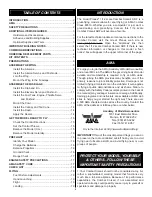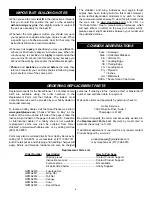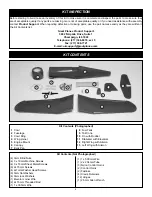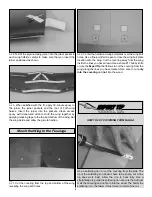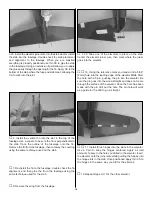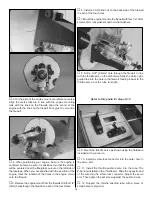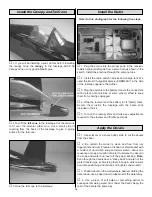
2.You must assemble the model according to the instructions.
Do not alter or modify the model, as doing so may result in an
unsafe or unflyable model. In a few cases the instructions may
differ slightly from the photos. In those instances the written
instructions should be considered as correct.
3. You must take time to build straight, true and strong.
4. You must use an R/C radio system that is in first-class
condition and a correctly sized engine and components (fuel
tank, wheels, etc.) throughout the building process.
5. You must correctly install all R/C and other components so
that the model operates correctly on the ground and in the air.
6. You must check the operation of the model before every
flight to insure that all equipment is operating and that the
model has remained structurally sound. Be sure to check
clevises or other connectors often and replace them if they
show any signs of wear or fatigue.
7. If you are not an experienced pilot or have not flown this
type of model before, we recommend that you get the
assistance of an experienced pilot in your R/C club for your
first flights. If you’re not a member of a club, your local hobby
shop has information about clubs in your area whose
membership includes experienced pilots.
8. While this kit has been flight tested to exceed normal use,
if the plane will be used for extremely high stress flying, such
as racing, or if an engine larger than one in the
recommended range is used, the modeler is responsible for
taking steps to reinforce the high stress points and/or
substituting hardware more suitable for the increased stress.
9. WARNING: The cowl and tail cone included in this kit are
made of fiberglass, the fibers of which may cause eye, skin
and respiratory tract irritation. Never blow into a part to
remove fiberglass dust, as the dust will blow back into your
eyes. Always wear safety goggles, a particle mask and
rubber gloves when grinding, drilling and sanding fiberglass
parts. Vacuum the parts and the work area thoroughly after
working with fiberglass parts.
Remember: Take your time and follow the instructions to
end up with a well-built model that is straight and true.
This is the list of hardware and accessories required to finish the
Combat Corsair. Order numbers are provided in parentheses.
❏
3 channel radio
❏
(3) Micro servos with 34 oz-in of torque
❏
(2) 12” [305mm] servo extensions
❏
Engine
❏
Propellers suitable for your engine.
In addition to common household tools and hobby tools, this
is the “short list” of the most important items required to build
the Combat Corsair.
Great Planes Pro
™
CA and Epoxy glues
are recommended.
❏
R/C foam rubber (1/4" [6mm] - HCAQ1000, or 1/2"
[13mm] - HCAQ1050)
❏
1/2 oz. [15g] Thin Pro CA (GPMR6001)
❏
1/2 oz. [15g] Medium Pro CA+ (GPMR6007)
❏
Pro 30-minute epoxy (GPMR6047)
❏
Pro 6-minute epoxy (GPMR6045)
❏
4-40 tap and drill set (GPMR8101)
❏
#1 Hobby knife (HCAR0105)
❏
#11 blades (5-pack, HCAR0211)
❏
R/C-56 canopy glue (JOZR5007)
❏
CA applicator tips (HCAR3780)
Here is a list of optional tools mentioned in the manual that
will help you build the Combat Corsair.
❏
Epoxy brushes (6, GPMR8060)
❏
Mixing sticks (50, GPMR8055)
❏
Mixing cups (GPMR8056)
❏
Builder’s Triangle Set (HCAR0480)
❏
Curved-tip canopy scissors for trimming
plastic parts (HCAR0667)
❏
Masking tape (TOPR8018)
❏
2 oz. [57g] spray CA activator (GPMR6035)
❏
Denatured alcohol (for epoxy clean up)
❏
Switch & Charge Jack Mounting Set (GPMM1000)
❏
Rotary tool such as Dremel
®
❏
Rotary tool reinforced cut-off wheel (GPMR8200)
❏
Servo horn drill (HCAR0698)
❏
Hobby Heat
™
micro torch (HCAR0750)
❏
Dead Center
™
Engine Mount Hole Locator (GPMR8130)
❏
AccuThrow
™
Deflection Gauge (GPMR2405)
❏
CG Machine
™
(GPMR2400)
❏
Precision Magnetic Prop Balancer
™
(TOPQ5700)
Optional Supplies and Tools
Adhesives and Building Supplies
Hardware and Accessories
ADDITIONAL ITEMS REQUIRED
We, as the kit manufacturer, provide you with a top quality,
thoroughly tested kit and instructions, but ultimately the
quality and flyability of your finished model depends on
how you build it; therefore, we cannot in any way
guarantee the performance of your completed model and
no representations are expressed or implied as to the
performance or safety of your completed model.
3


